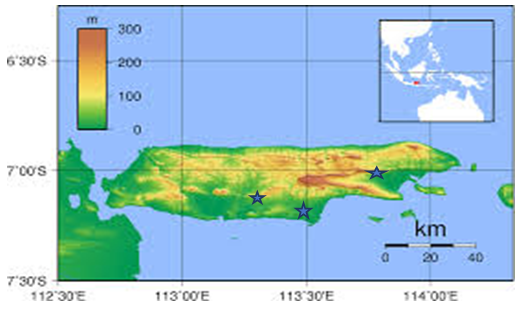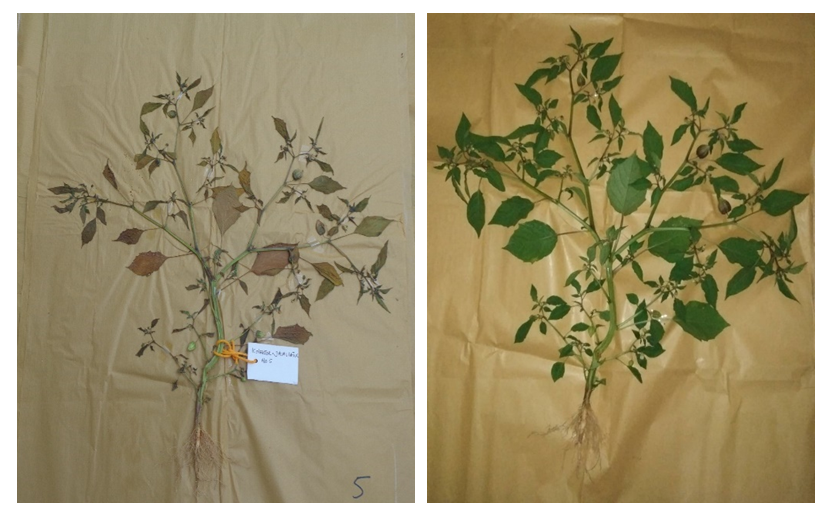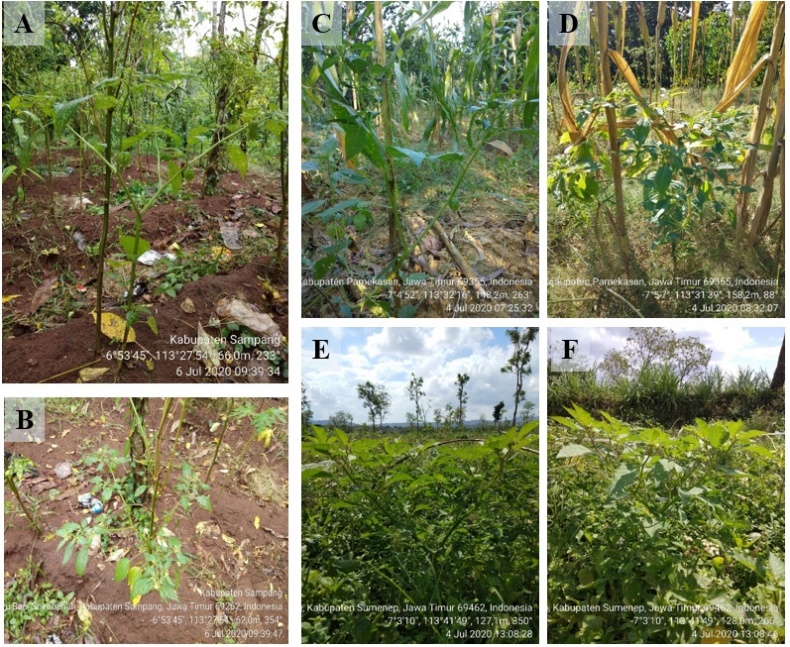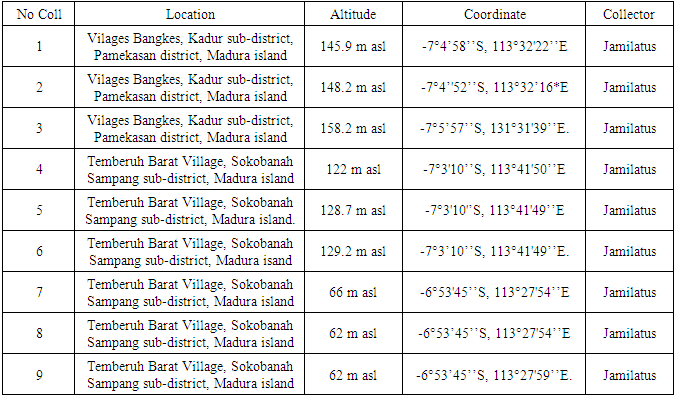-
Paper Information
- Paper Submission
-
Journal Information
- About This Journal
- Editorial Board
- Current Issue
- Archive
- Author Guidelines
- Contact Us
International Journal of Agriculture and Forestry
p-ISSN: 2165-882X e-ISSN: 2165-8846
2023; 13(1): 31-35
doi:10.5923/j.ijaf.20231301.03
Received: Oct. 30, 2023; Accepted: Nov. 11, 2023; Published: Nov. 29, 2023

Ethnobotany Yor-nyiuran (Physalis angulata L.) Family Solanaceae in Madura, East Java, Indonesia
Jati Batoro1, Retno Mastuti1, Budi Waluyo2
1Department of Biology Faculty of Mathematics and Natural Sciences, Brawijaya University, East Java, Indonesia
2Agronomy Department, Faculty of Agriculture, Brawijaya University, East Java, Indonesia
Correspondence to: Jati Batoro, Department of Biology Faculty of Mathematics and Natural Sciences, Brawijaya University, East Java, Indonesia.
| Email: |  |
Copyright © 2023 The Author(s). Published by Scientific & Academic Publishing.
This work is licensed under the Creative Commons Attribution International License (CC BY).
http://creativecommons.org/licenses/by/4.0/

Madura Island is well known for its traditional herbal ingredients that have been produced from generation to generation. Yor-nyiuran (Physalis angulata L.) is one of a small species by local Madurese people used medicine, food and growth wilds. Examination of herbarium material was carried out based on Herbarium Brawijaya University (HBUR). This explorative study uses open-ended interviews and semi-structured interviews. Result of this study is important to be used as basic information function in human life is for traditional medicine (high blood pressure, diabetes mellitus, cancer) sometime food and variation species in the Madura island, East Java. This research shows that the yor-nyiuran plant grows wild and in the agricultural environment of Madura Island, identified is new record as Physalis angulata L. These results also indicate the importance of the yor-nyiuran plant for the Madurese community, especially in its use as medicine.
Keywords: Yor-nyiuran (Physalisangulata), Madura island, Madurese people, East Java
Cite this paper: Jati Batoro, Retno Mastuti, Budi Waluyo, Ethnobotany Yor-nyiuran (Physalis angulata L.) Family Solanaceae in Madura, East Java, Indonesia, International Journal of Agriculture and Forestry, Vol. 13 No. 1, 2023, pp. 31-35. doi: 10.5923/j.ijaf.20231301.03.
Article Outline
1. Introduction
- Ethnobotany also learns about how people from certain cultures and regions make use of plants native to certain areas. History has shown human dependence on plants to meet their various needs. Ethnobotany is the study of the relationship between humans and plants [8,12]. Besides contributing to the air we breathe, plants also provide clothing, food and shelter. Many indigenous people also use plants in spiritual ceremonies or rituals. Ethnobotany helps people gather information about how people have traditionally used certain plants as medicinal plants, what diseases can be treated and how are they used in medicine [8,5]. The genus yor-nyiuran, ciplukan (Physalis spp.) is herbaceous shrubs, hollow stems, round-ribbed, smooth surface, green-white-dark. The bell-shaped, ribbed flowers are included in the nightshade family Solanaceae. Information from Flora of Java [3] by stated that in Java there are 3 types of yor-nyiuran namely Physalis minima, P. angulata and P. peruviana. Physalis peruviana grows and is spread between cultivated plants and forests with an altitude of 1000-2400 meters above sea level, while P. minima and P. angulata grow optimally at an altitude of 2-600 meters above sea level [6]. This family member grows wild among cultivated plants and is toxic, but can be used as fruit and medicinal ingredients [6,14]. Members of this genus are scattered in locations with a variety of altitudes, special temperature environments and like fertile places, spread from subtropical-tropical regions [2]. The Madurese with their unique language and culture are one of the second largest tribes in East Java who occupy the island of Madura. Madurese ciplukan plant is called yor-nyiuran (Physalis spp.), rarely cultivated and grows wildly but can be used for various purposes, including traditional medicinal ingredients; high blood pressure, diabetes mellitus and drugs exposed to toxins. [17,22,16,18,13] reported informed that Physalis spp. by local people used to increase appetite, mouth sores, tonics, diuretics, laxatives, inflammation, and enlargement of the spleen and stomach problems. The purpose of this study is to determine the diversity of yor-nyiuran species (Physalis spp.) and reveal knowledge about its benefits on the island of Madura.The Madurese with their unique language and culture are one of the second largest tribes in East Java who occupy the island of Madura. Madurese ciplukan plant is called yor-nyiuran (Physalis spp.), rarely cultivated and grows wildly but can be used for various purposes, including traditional medicinal ingredients; high blood pressure, diabetes mellitus and drugs exposed to toxins. The purpose of this study is to determine the diversity of yor-nyiuran species (Physalis spp.) and reveal knowledge about its benefits on the island of Madura.
2. Materials and Methods
- The study based on the examination of the material from Herbarium Biology of Brawijaya University (HBUR) collection, fresh material from Madura island areas covers Sampang Regency, Pamekasan Regency and Sumenep Regency (Fig. 1), East Java Indonesia. Standard plant specimen collection tecniques were employed. From the collection studied by the author, details and descriptions from dried material, except for floral and fruit sizes, which were based on dehydrated (boiled in water) material. Terminologies follows [7,11] and methods follows by [4]. The research was conducted using explorative study used indept interview, semi-structure [8,12].
 | Figure 1. Madura island Map, star sign regency (Sampang, Pamekasan and Sumenep) (Anonymous, 2020) |
3. Results and Discussion
- Physalis angulata L.Flora of Java 2 (1968): 467-468; Sp. Pl. 1: 183. 1753; Sendtner in Martius, Fl. Bras. 10: 130. 1846. Lectotype (designated by D’Arcy, 1974: 662): “Habitat in India utraque,” Herb. Linn. No. 247.9 (LINN) fide D'Arcy in Woodson & Schery (ed.), Ann. Missouri Bot. Gard. 60: 662 (1974). Isolectotype of Physalis angulata L. Edward (1887) Mexico. YPM YU YU 065297. Physalis angulata L., sinonim Physalis glaberrima Colla (De Moraes et al., 2014)Branched roots, white-yellowish color. Terrestrial, herbaceous, seasonal-perennial, upright, branched, more or less, 0.29 cm- 0.85 m high. Stem diameter 0.3-1 cm, rectangular ribbed sharp-round, smooth, hollow, green-brown surface interspersed with pink, smooth to fine-haired dense-sparse (pubescent). The internodes are 3-8 cm long, the nodes are slightly enlarged, where the shoots, petioles and flowers appear. Petiole is quadrilateral lengthening 2,3-6 cm, oval leaf blade extending to a lanceolate shape, 3-11 cm x 2,5-6 cm with pointed-tapered tip, flat edge or sharp serrated, with fine hair; the base of the leaves is pointed at different distances up to 0.2-0.8 cm; upper leaf surface green-gloomy, lower surface green-whitish. The flowers are axillary and solitary intersection of the branches of the stem. Upright flower stalk with a round nodding tip, 1-1.5 mm in diameter, appears on the armpits of each branch, green, violet-brown 0.8-3 cm. Elongated round petals, sticky green, 1.5-2.7 x 1.7-2.5 cm, 5 slits, sharing a triangular shape at the tip, 1 cm taper, ribbed brown-violet with fine white hair. Bell-shaped crown of light yellow-yellow color with a green base, 7-9 mm, edge notched 5; deep neck with yellow-brown stain; on each node there are clusters of short, dense hair in a ‘v’ form or spiral. Stalk 1 mm, pale yellow; anthers 1 mm, light blue. Sleek pistil, button-shaped head. The adult fruit petals are oval hanging green, while the old ones are yellow, 2.1-2.4 x 3-3 cm veined brown-violet. Buni fruit, in large quantities per individual, slightly elongated round, rounded tip, 1-1.3 x 1-2 cm, smooth, shiny, green when young, medium ripe yellow. Young seeds are white scattered on the edge and center (Figure 2,3).
|
 | Figure 2. Specimen Yor-nyiuran (Physalis angulata L.) |
 | Figure 3. The location of sampling for the accession of yor-nyiuran (Physalis angulata) plants in three districts in Madura island. A-B: Sampang, C-D: Pamekasan, E-F: Sampang |
4. Conclusions
- Based on studies one species of Physalis angulata L. is new record from Madura island, East Java. Ciplukan, yor-nyiuran (Physalis angulata L.) important to be used as basic information function in human life is for traditional medicine. Yor-nyiuran (P. angulata L.) can treat 9 types of diseases including covers diabetes mellitus, cancer, fever, prostate, high blood pressure, stomach ache, accelerating breast milk, uric acid, food/fruit and cholesterol. sometime food and meaning it is quite important species in Madurese community.
ACKNOWLEDGEMENTS
- The authors would like to express their gratitude to Deparment Biology FMIPA Brawijaya University, doctoral grant funds financial supports during our research. The author would like to thanks local informans and collector Mrs. Jamilatus, Madurese local and A. Ichsan laboratorium Biology Universitas Brawijaya.
 Abstract
Abstract Reference
Reference Full-Text PDF
Full-Text PDF Full-text HTML
Full-text HTML